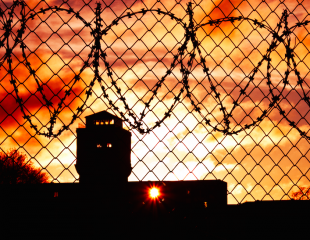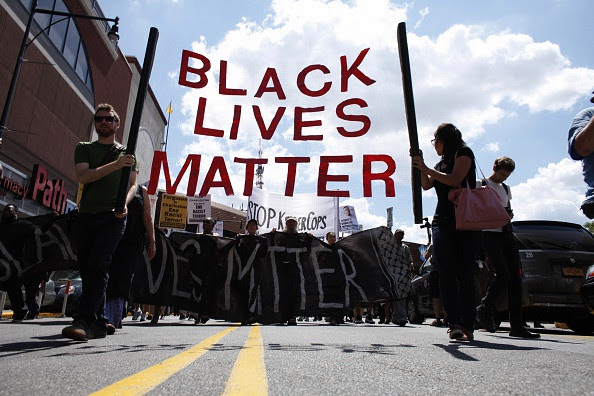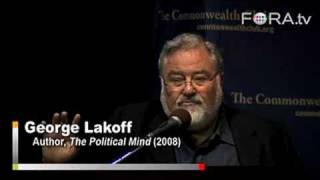By Kali Holloway / AlterNet

Almost 160,000 prisoners are currently serving life sentences in the United States; nearly 50,000 incarcerated people serving terms of life without parole. While mass incarceration has become a frequent national talking point across the board, with even previous tough-on-crime hardliners acknowledging the devastating consequences of overincarceration, “lifers” are often left out of the conversation.
This omission—as with so many issues of advocacy, justice and picking battles—is based on a certain perceived practicality. Within the context of the already hard-fought movement for prison reform, it’s easier to gain support for those whose sentences are not associated in the public mind with the most egregious crimes. The fear is that expanding the reform vision to include lifers—particularly those charged with violent crimes—may turn people off and potentially erode strides made in recent years.
Numbers, however, have inevitably begun to force that necessary discussion. In a country where the death penalty still exists though is (though not fast enough) falling out of favor, the false notion of life sentences as merciful alternatives—and a national character steeped in racism and punishment—has led to an explosion in their use. Even as crime rates nationally continue their two-decade decline, sentences of life and life without parole have increased.
According to the Sentencing Project, between 2008 and 2012, there was an 11.8 percent rise in the number of people serving life sentences, and the organization estimates that the “lifer population has more than quadrupled in size since 1984.” One out of every nine prisoners is serving a life term. The number of prisoners with sentences of life without parole has jumped by nearly a quarter since 2008, increasing 22.2 percent to more than 49,000. Make no mistake, these prisoners have been sentenced to die, not with immediacy of electrocution or lethal injection, but on prison grounds.
Inmates of color have, as with every troubling American trend, been disproportionately impacted by this expansion in full-life sentencing. In the 1980s and ‘90s, as presidents Reagan, Bush and Clinton waged wars on drugs and crime that took aim at poor African Americans, the number of people in prison skyrocketed. Political expediency, misguided moral hysteria and race-based disparities in sentencing have heavily contributed to a lifer population that is approximately 47 percent black (though far greater in parts of the South).
One out of six lifers are Latino (reaching far higher concentrations in parts of the West and Southwest). Fifty-eight percent of those now jailed with no chance of parole are African American. This country’s dedication to being the most carceral state in the western world is matched only by its affinity for putting black folks away forever.
Clemency efforts, such as President Obama’s 2014 initiative, have focused on commuting the sentences of those with nonviolent offenses. (Obama is the first sitting president to visit a federal prison, and has shortened the sentences of 348 prisoners, more than his seven predecessors combined.) The steps taken by this administration to address the issue of mass incarceration are unprecedented, raising what has long been an exceptionally low bar.
America’s jails still house roughly 10,000 lifers convicted of nonviolent offenses, 2,500 of them for drug-related crimes and 5,400 for property offenses. A much higher proportion—the New York Times points to federal data pegging the figure at more than 50 percent—were charged with violent crimes, including homicide.
The New York Times points to the case of Lenny Singleton, who at age 28 committed a series of robberies over the course of a week in 1995, mostly to get money for his crack addition. Singleton “either distracted a clerk or pretended to have a concealed gun before stealing from the cash register,” and once carried a kitchen knife with him, but never injured anyone. In all, during his brief crime spree, carried out in a haze of alcohol and cocaine, Singleton stole about $500.
He was tried in a Virginia court, before William F. Rutherford, a Southern judge known for imposing long sentences during an era in which crack addicts were routinely sent to jail for stints far greater than befitted their crimes. “What he needed was some help with his addiction,” Singleton’s wife recently wrote in an open letter. “What he got was two life sentences plus 100 years.”
“Crack cocaine scared the hell out of a lot of people,” William G. Broaddus, who formerly served as Virginia’s attorney general, told the Times. “It’s disappointing there wasn’t more consideration as to why this man did this. Do we really want to keep him in jail for the rest of his life? Having said that, it doesn’t surprise me in the slightest that this judge meted out the sentence that he did.”
Singleton’s sentence is extreme by any measure. As the Times points out, the maximum sentence for second-degree murder in the state of Virginia is 40 years. Shameful racial disparities persist in sentencing in the state, as well as all over this country. But the Times points to recent cases involving black defendants charged with more violent offenses that resulted in sentences a fraction the length of Singleton’s. And yet, Singleton’s case is the sort the mainstream reform movement has been slow to embrace, because it doesn’t wholly measure up to the nonviolent offender ideal.
“I was out of my mind on drugs, but I wasn’t going to hurt anybody,” Singleton told the Times. “I was just after the money.”
If the push to right the wrongs of overincarceration has any hope of actually moving forward, a more complex approach to prison reform will undoubtedly be necessary. Remedying mass incarceration, if that is the real goal, would necessarily involve looking beyond the limits of the current mainstream discussion. That means considering new approaches for a wider population of inmates. In a piece in the New Yorker a few months ago, Clint Smith cites an articleby law writer Gilad Edelman which ran in the magazine a year prior. “Even if every single nonviolent drug offender were released tomorrow, the [U.S.] incarcerated population would stand at around 1.7 million,” Edelman wrote, “still nearly a fifth of the world total.”
There have been very modest movements of late. In multiple rulings over the last decade, the Supreme Court has considered emerging scientific knowledge about the developing, immature brains of teenagers in issuing decisions that rule out the death penalty and life without parole for offenders 18 and under. Earlier this year, in Montgomery v. Louisiana, the court ordered retroactive application of its 2012 ruling that “mandatory life sentence without parole should not apply to juveniles convicted of murder.”
The Sentencing Project report indicates that “more than 10,000 life-sentenced inmates have been convicted of crimes that occurred before they turned 18 and nearly 1 in 4 of them were sentenced to [life without parole],” and presumably, these inmates would have their cases come up for review. SCOTUS’ decisions may finally end the U.S.’ status as the only country that subjects its youth to such harsh sentencing, effectively sending them to die in jail.
Implementing sentencing reforms, including the abolishment of life without parole, as recommended by the Sentencing Project, would also be key here. Congress should pass the Sentencing Reform and Corrections Act, a bipartisan bill that would “reduce several federal mandatory minimum drug and gun sentences and make those reductions retroactive for some people.” A 2011 ProPublica investigation found that under Bush 43, white prisoners were four times more likely to receive presidential pardons than minorities. Though the Obama administration has said it is taking steps to address those disparities, it’s a safe bet that more could be done.
It would be foolhardy to expect a willingness to undertake the overhaul truly necessary, which would require a decades long commitment and the eradication of the prison-industrial complex. But this is where we are, and it will be interesting to see where we go from here. At the very least, it seems important to recognize that our system of criminal justice, designed to subjugate some while making others rich, has not been fixed in whole or in part because of the tonal shift around overincarceration.
“People are celebrating the stabilization of the prison population in recent years,” Marc Mauer, executive director of the Sentencing Project, told the New York Times, “but the scale of mass incarceration is so substantial that meaningful reduction is not going to happen by tinkering around the edges.”
|
11:37 PM (9 hours ago)
 |
  |
||
|
||||
How to Go From #BlackLivesMatter to #BlackPolicyMatters
 Demonstrators march during a Michael Brown memorial protest in Brooklyn, N.Y., Aug. 9, 2015. KENA BETANCUR/AFP/Getty Images
Demonstrators march during a Michael Brown memorial protest in Brooklyn, N.Y., Aug. 9, 2015. KENA BETANCUR/AFP/Getty ImagesHow do we go from #BlackLivesMatter to changing the policies that devalue black life?
This moment feels both full of possibility and also in danger of going unfulfilled. Folks across the political spectrum are finally confronting the issue of police violence, but there’s little consensus about how to fix it. Organizations like Campaign Zero are doing impressive work mapping out solutions, but its 10-point program is a road map for the long haul.
To take advantage of the fierce urgency of now, activists need to coalesce around one demand. William Gamson, who studied 53 different social movements in the United States between 1800 and 1945, found that challenging groups with single-issue demands were generally more successful than groups with multiple demands.
What ambitious, but achievable, policy reform could be prioritized? It’s a tough question because so many different policies contribute to horrific incidents like the shootings of Philando Castile and Alton Sterling. Samuel Sinyangwe of Campaign Zero suggests changing the police standard for use of deadly force. Many argue that police-union contracts protect cops after misconduct or abuse. Civil asset-forfeiture laws have also come under scrutiny for creating financial incentives to harass marginal folks who might have “goodies” that can be auctioned off to fund a department. Finally, numerous scholars and activists argue for ratcheting down the war on drugs. Like alcohol prohibition, drug prohibition creates a vast underground economy that increases violence and social conflict, both within poor communities and between police and citizens.
Unfortunately, all of these ideas are probably a little too wonky or far-reaching to rally a wide range of folks toward a near-term political consensus. What’s needed is a policy proposal that could significantly reduce police violence and that can easily be distilled down to the kind of slogan that might naturally follow a chant of #BlackLivesMatter.
What does that leave? One demand worth considering flows from the Pareto principle, often known as the “80-20 rule.” The basic idea is that, in many contexts, the vast majority of the outcomes are the result of only a small percentage of the inputs. For example, a company might find that nearly 80 percent of its revenue is generated by about 20 percent of its sales force.
Conversely, an organization might find that most of the bad outcomes are caused by a small percentage of the employees. In the movie Waiting for Superman, for example, Stanford economist Eric Hanushek notes that if the United States could replace the bottom-performing 6 percent to 10 percent of teachers, our underperforming public schools would approach the quality of education available to kids in Finland, which has one of the highest-performing school systems in the world.
A recent study of civilian complaints and disciplinary histories for 35,000 New York Police Department officers found that a small number of officers were disproportionately responsible for citizen grievances. The Civilian Complaint Review Board records show 40 percent of NYPD officers have never been the subject of a citizen complaint. Twenty percent have only one complaint. Approximately 1,000 officers, or about 3 percent, however, have 10 or more complaints.
Another study of police in Chicago showed similar results. Looking at every complaint filed against Chicago police between Jan. 1, 2011, and Dec. 7, 2015, researchers found that more than half of the officers received fewer than one complaint a year. By contrast, the worst 1 percent of officers generated about 25 percent of the complaints.
As one expert said, “If you could devise a system to identify [problem cops] early, you could prevent a lot of inappropriate actions out there on the street.”
Many activists, columnists and pundits reject or criticize the “bad apple” narrative as a simplistic evasion of the deep, systemic problems in American policing. And it’s true—retraining, removing from the street or firing “repeaters” won’t, by itself, change numerous other structural flaws. Focusing on the officers who generate a disproportionate number of misconduct complaints, however, can serve as a powerful indictment of how little accountability there is for many police officers.
Political victories are often won by framing an issue in a way that points to only one reasonable solution. Also, people typically make sense of the world through stories. Focusing the public’s attention on individual officers who are repeatedly accused of misconduct but are never penalized, powerfully challenges the conventional narrative about policing and can reshape the terms of the debate. What coalition is going to stand behind an NYPD officer with 51 complaints?
More importantly, focusing on police officers accused of extreme misconduct could significantly reduce state-sanctioned violence against black civilians. Eric Garner, Tamir Rice and Laquan McDonald might be alive today if abusive and incompetent officers had been denied the privilege of a badge and a gun.
For #BlackLivesMatter to translate influence into policy, a national chorus of voices must increasingly speak as one. A strategy of drawing attention to those officers repeatedly accused of misconduct is not going to dismantle systemic injustice. It would, however, be a start.
Omar Wasow is an assistant professor in Princeton’s Department of Politics. His research focuses on race and politics, protest movements and statistical methods. Before joining the academy, Omar served as a regular on-air technology analyst and was co-founder of BlackPlanet.com. Follow him on Twitter.















